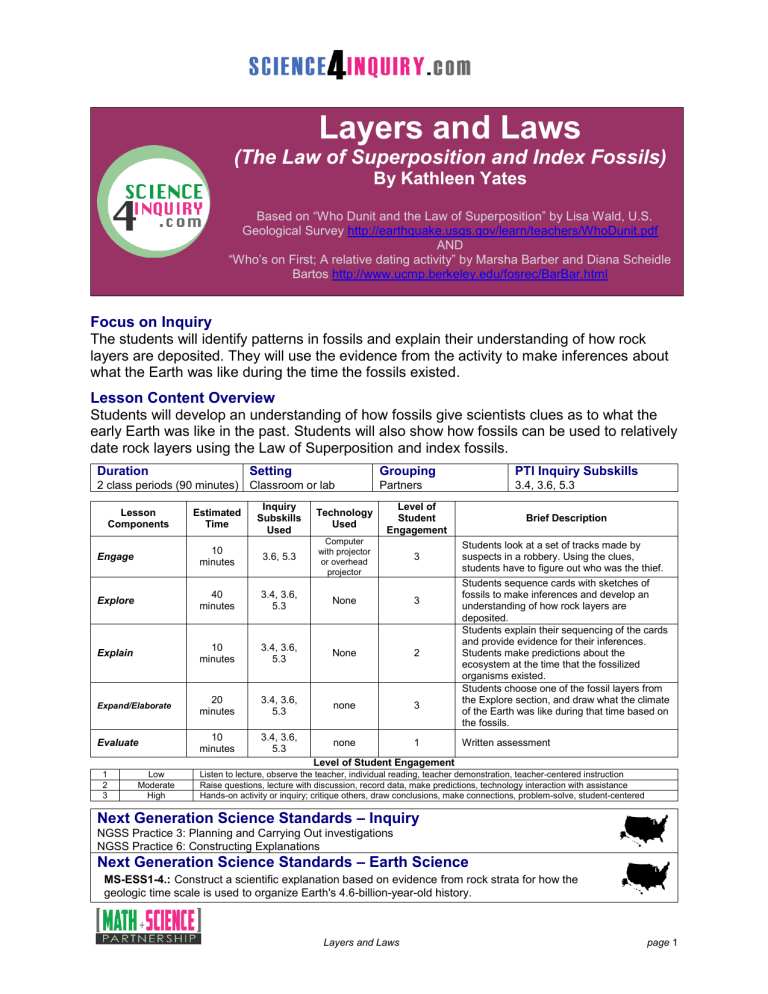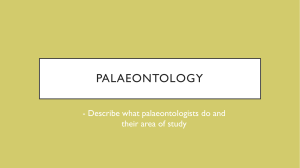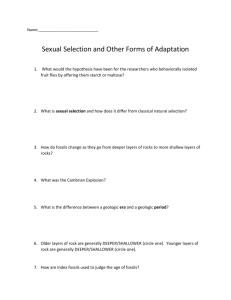
Layers and Laws (The Law of Superposition and Index Fossils) By Kathleen Yates Based on “Who Dunit and the Law of Superposition” by Lisa Wald, U.S. Geological Survey http://earthquake.usgs.gov/learn/teachers/WhoDunit.pdf AND “Who’s on First; A relative dating activity” by Marsha Barber and Diana Scheidle Bartos http://www.ucmp.berkeley.edu/fosrec/BarBar.html Focus on Inquiry The students will identify patterns in fossils and explain their understanding of how rock layers are deposited. They will use the evidence from the activity to make inferences about what the Earth was like during the time the fossils existed. Lesson Content Overview Students will develop an understanding of how fossils give scientists clues as to what the early Earth was like in the past. Students will also show how fossils can be used to relatively date rock layers using the Law of Superposition and index fossils. Duration Setting 2 class periods (90 minutes) Classroom or lab Grouping PTI Inquiry Subskills Partners 3.4, 3.6, 5.3 Estimated Time Inquiry Subskills Used Technology Used Level of Student Engagement Engage 10 minutes 3.6, 5.3 Computer with projector or overhead projector 3 Explore 40 minutes 3.4, 3.6, 5.3 None 3 Explain 10 minutes 3.4, 3.6, 5.3 None 2 Expand/Elaborate 20 minutes 3.4, 3.6, 5.3 none 3 Evaluate 10 minutes 3.4, 3.6, 5.3 none 1 Lesson Components Brief Description Students look at a set of tracks made by suspects in a robbery. Using the clues, students have to figure out who was the thief. Students sequence cards with sketches of fossils to make inferences and develop an understanding of how rock layers are deposited. Students explain their sequencing of the cards and provide evidence for their inferences. Students make predictions about the ecosystem at the time that the fossilized organisms existed. Students choose one of the fossil layers from the Explore section, and draw what the climate of the Earth was like during that time based on the fossils. Written assessment Level of Student Engagement 1 2 3 Low Moderate High Listen to lecture, observe the teacher, individual reading, teacher demonstration, teacher-centered instruction Raise questions, lecture with discussion, record data, make predictions, technology interaction with assistance Hands-on activity or inquiry; critique others, draw conclusions, make connections, problem-solve, student-centered Next Generation Science Standards – Inquiry NGSS Practice 3: Planning and Carrying Out investigations NGSS Practice 6: Constructing Explanations Next Generation Science Standards – Earth Science MS-ESS1-4.: Construct a scientific explanation based on evidence from rock strata for how the geologic time scale is used to organize Earth's 4.6-billion-year-old history. Layers and Laws page 1 Florida Science Standards – Nature of Science SC.7.N.1.6: Explain that empirical evidence is the cumulative body of observations of a natural phenomenon on which scientific explanations are based. Florida Science Standards – Earth and Space Science SC.7.E.6.3: Identify current methods for measuring the age of Earth and its parts, including the law of superposition and radioactive dating. SC.7.E.6.4: Explain and give examples of how physical evidence supports scientific theories that Earth has evolved over geologic time due to natural processes. Materials and Advance Preparation Materials List Copies of Blackline Master 2 (cut into cards) – one set of cards per pair of students Copies of Blackline Master 3 – one copy per pair of students Copies of Blackline Master 4 – one copy per student Colored pencils and white paper Blackline Master 1: “Who Dunit” Graphic Blackline Master 2: Fossil Cards Blackline Master 3: Fossil Information Blackline Master 4: Layers and Laws Student Activity Sheet Blackline Master 5: Superposition Answer Guide for Fossil Cards Blackline Master 6: Layers & Laws Check for Understanding Blackline Master 7: Answer Keys Advance Preparation 1. 2. 3. 4. Make copies of Blackline Master 2 and cut into cards (see Materials list). a Optional: You may want to laminate card sets of Blackline Master 2 for future use. Make copies of Blackline Master 3 (1 per pair of student). Make copies of Blackline Master 4 (1 per person) Make copies of Blackline Master 6 (1 per person) Lesson Information Learning Objectives The learner will analyze and interpret data and think critically and logically to make the relationships between evidence and explanations communicate results discover index fossils discover the Law of Superposition Prior Knowledge Needed by the Students Sedimentary rock formation and fossil formation Background Information Superposition is the principle that states that, in undisturbed sedimentary rock, newer layers will be deposited over older layers; thus, in a core sample, those samples of Earth and rock nearest the surface will be newer in age than those beneath them. Fossils that develop in a rock layer can help scientists determine a relative time when the rock layer formed. These fossils are called “index fossils.” When these fossils are found in other layers of rock around the world, scientists have a general understanding of how old the rock layers are and what can be expected to be found in the surrounding rock layers. Layers and Laws page 2 Lesson Procedure Engage 1. Pass out the student activity sheet (Blackline Master 4) to each student. 2. Place the graphic “Who Dunit” on the projector (Blackline Master 1). Allow students draw conclusions about who the thief would be based on the evidence shown. As the students are coming up with their ideas, ask questions to guide their thinking such as: - How could you prove who did it? (student responses will vary) - What evidence did you use? (student responses will vary) 3. As a class, share out the student’s ideas about who the thief is. They should justify their prediction with the evidence they used. 4. Once the correct thief has been identified, discuss how the Earth gives us clues as to what it was like long ago. These clues are called fossils. Have students list out what they already know about fossils. Tell students they will be using fossils to predict what the Earth was like long ago and how the Earth had changed over time. Explore 1. Pass out the set of cards with the pictures of fossils on them (Blackline Master 2) to each partnership of students. a. Have the students spread out the cards in front of them. b. Remind students that the pictures on the cards represent already known and dated fossils. c. Have the students put the cards in a logical order based on the pictures on the cards. d. The partners should work together, justifying why the cards were placed in that order. 2. Some questions you can ask students while they work include: a. How did you figure out where the cards should be placed? (Used the pictures, Index fossils) b. What does each card represent? (A layer of rock) – Refer back to the answers displayed as layers of rock. c. Which layer is the oldest? How do you know? (The bottom layer) – Remind students of the engage activity. d. Which layer is the youngest? How do you know? (The top layer) – Refer back to the engage activity. 3. Student should begin completing the reflective part of the student activity sheet (Blackline Master 4). Explain 1. Student should complete the reflective part of the student activity sheet (Blackline Master 4). 2. Place the correct order of the cards up on the projector (Blackline Master 3). In partners, students should check to see how close their cards were to the correct order. 3. This should lead to a class discussion about index fossils, relative and absolute dating, and Law of Superposition (a review of the student activity sheet – Blackline Master 4). 4. Some additional questions for discussion include: a. How do scientists know how old these index fossils are? (Absolute dating) b. Describe a time you put something into layers (sandwich, ice cream sundae, Avid binder, laundry, etc.) c. In science, what do we call the idea that rocks, and the fossils contained in those rocks, are layered in order with the oldest rock being on the bottom? (Law of Superposition) Expand 1. Have students choose one of the layers (cards) from the engage activity and draw what the environment on Earth was like during that period of time (to show how Earth has changed). Layers and Laws page 3 Evaluate 1. Informal/Formative Evaluation: Observation of student’s progress and understanding through the activity. 2. Formal/Summative Evaluation: Layers & Laws Check for Understanding (Blackline Master 6) Supplementary Resources Teachers Rocks and Time: http://pubs.usgs.gov/gip/fossils/contents.html Contains information about rock layers, fossils, geological time and other information related to the formation of rock layers. CITATION OF SOURCES. Barber, M. & Bartos, D. (n.d.) Who’s on First; A relative dating activity. Retrieved from http://www.ucmp.berkeley.edu/fosrec/BarBar.html (No part of the referring document residing on the server, www.ucmp.berkeley.edu, may be reproduced or stored in a retrieval system without prior written permission of the publisher, except for educational purposes, and in no case for profit.) Encyclopedia Britannica. (2016). Index Fossils. Retrieved from http://www.britannica.com/science/indexfossil Nadirrias. (2011). Wikipedia Commons: Superposition Picture. Retrieved from https://commons.wikimedia.org/wiki/File:Law_pos.gifb Wald, L. (n.d.). US Geological Survey: Who Dunit and the Law of Superposition. Retrieved from http://earthquake.usgs.gov/learn/teachers/WhoDunit.pdf ____ Yes, I cited all materials and resources used in this lesson. Kathleen Yates Lesson author signature Layers and Laws page 4 Blackline Master 1 Who Dunit? (used with permission from Steve Dutch, Univ. of Wisconsin, Green Bay) Someone took the last cookie in the cookie jar last night. The last person to leave the scene is the culprit. Who was it? Clues: The Butler walks to work. The Handyman rides a bike. The Cook rides a motorcycle. The Maid drives a car. The Nephew has a seeing-eye dog. Layers and Laws page 5 Blackline Master 2 Fossil Cards Courtesy of http://www.ucmp.berkeley.edu/fosrec/BarBar.html#SETB with permission for educational uses. Layers and Laws page 6 Courtesy of http://www.ucmp.berkeley.edu/fosrec/BarBar.html#SETB with permission for educational uses. Layers and Laws page 7 Blackline Master 3 Fossil Information Courtesy of http://www.ucmp.berkeley.edu/fosrec/BarBar.html#SETB with permission for educational uses. Layers and Laws page 8 Blackline Master 4 Layers and Laws Student Activity Sheet Engage: Who Dunit? Who do you think the culprit is? ______________________________ What evidence do you see that leads you to this conclusion? ___________________________________ ____________________________________________________________________________________ ____________________________________________________________________________________ Explore/Explain Index fossils are fossils that are preserved in the rock record of the Earth and are specifically found in a particular time period or environment. These fossils are also called, guide fossils. What can the index fossils tell you about the organisms in the layers of rock with them, above them, or below them? ______ ____________________________________________________________________________________ ____________________________________________________________________________________ ____________________________________________________________________________________ Based on the information that is given about each type of fossil, what can you infer about the type of environment these fossils may have lived in? _______________________________________________ What evidence did you use to make your inference? _________________________________________ ____________________________________________________________________________________ Are your oldest fossils and rock layers on the top or the bottom of your model? _____________________ Why did you arrange them this way? ______________________________________________________ ____________________________________________________________________________________ The Law of Superposition states that in a series of sedimentary rock layers, the oldest layer is at the bottom, and layers from there upward become younger and younger. How is this related to how you organized your fossils and rock layers? ____________________________________________________ ____________________________________________________________________________________ ____________________________________________________________________________________ Think about your laundry. How might the Law of Superposition apply to which clothes have been in your laundry the longest (the oldest) and which clothes have been in your laundry the shortest (the youngest)? __________________________________________________________________________ ____________________________________________________________________________________ ____________________________________________________________________________________ Draw a picture that represents the Law of Superposition. Label the picture with which layers are the oldest and which layers are the youngest. Layers and Laws page 9 Blackline Master 5 Superposition Answer Guide for Fossil Cards Figure 2-B. Stratigraphic Section for Set B (use as answer key) Courtesy of http://www.ucmp.berkeley.edu/fosrec/BarBar.html#SETB with permission for educational uses. Layers and Laws page 10 Blackline Master 6 Layers and Laws Checking for Understanding 1. Using the diagram above, which layer would contain the oldest fossils? (SC.7.E.6.3) a. Layer A b. Layer C c. Layer D d. Layer E 2. Scientists can learn all of the following by studying fossils EXCEPT: (SC.7.E.6.4) a. How life forms have changed over time b. How the environment has changed over time c. How the Earth’s surface has changed over time d. How the surrounding rock layers have changed over time 3. What evidence did scientists use to develop the Law of Superposition? (SC.7.N.1.6) a. Fossils only b. Rock layers only c. Rock layers and fossils d. Fossils and environment 4. A new fossil is found in a rock layer in England. How can index fossils be used to help date the approximate age of the new fossil? (SC.7.E.6.4) a. Scientists use radioactive dating to get the exact age of the new fossil. b. Scientists compare the new fossil directly to known fossils to find its age. c. Scientists use the fossils around the new fossil to compare to known fossils. d. Scientists ask other scientists to date the fossils based on known information. Layers and Laws page 11 Blackline Master 6 – Answer Keys Layers and Laws Student Activity Sheet – Answer Key Engage: Who Dunit? Who do you think the culprit is? student responses will vary. Correct answer is nephew walking dog What evidence do you see that leads you to this conclusion? student responses will vary but should include that these foot prints were over top all of the others, indicating that it happened most recently. Explore/Explain Index fossils are fossils that are preserved in the rock record of the Earth and are specifically found in a particular time period or environment. These fossils are also called, guide fossils. What can the index fossils tell you about the organisms in the layers of rock with them, above them, or below them? student responses will vary but should include that index fossils can tell you that the organisms in the same layer are approximately the same age and lived at approximately the same time, fossils in layers on top of the index fossils are younger, fossils in the layers below the index fossils are older. Based on the information that is given about each type of fossil, what can you infer about the type of environment these fossils may have lived in? student responses will vary but should point to the idea that this was an aquatic environment. What evidence did you use to make your inference? student responses will vary but should include that there is mention on the “Fossil Information” page that the students were “swimmers” or lived in “aquatic” or “marine” environments. There are many mentions of “fish” which students should recognize as living in water. Are your oldest fossils and rock layers on the top or the bottom of your model? student responses will vary. Correct answer is that the oldest rock layers are at the bottom. Why did you arrange them this way? student responses will vary but should include an explanation that newer layers cannot be layed until older layers are already established. The Law of Superposition states that in a series of sedimentary rock layers, the oldest layer is at the bottom, and layers from there upward become younger and younger. How is this related to how you organized your fossils and rock layers? student responses will vary but should include that putting the fossil layers in order from the oldest layers that talk about “extinct” organisms to the more recent organisms that say “still in existance” follows the law of superposition that oldest layers are on the bottom and newest layers are on the bottom. Think about your laundry. How might the Law of Superposition apply to which clothes have been in your laundry the longest (the oldest) and which clothes have been in your laundry the shortest (the youngest)? student responses will vary but could include that the oldest laundry is in the bottom. Every time the student dirties more clothes, they get put on top of the older, dirty clothes. The ones on the bottom have been in the laundry the longest, the ones on top the shortest. Draw a picture that represents the Law of Superposition. Label the picture with which layers are the oldest and which layers are the youngest. student drawings may vary but should generally look like this: Layers and Laws page 12 Checking for Understanding – Answer Key 1. Using the diagram above, which layer would contain the oldest fossils? (SC.7.E.6.3) a. Layer A b. Layer C c. Layer D d. Layer E 2. Scientists can learn all of the following by studying fossils EXCEPT: (SC.7.E.6.4) a. How life forms have changed over time b. How the environment has changed over time c. How the Earth’s surface has changed over time d. How the surrounding rock layers have changed over time 3. What evidence did scientists use to develop the Law of Superposition? (SC.7.N.1.6) a. Fossils only b. Rock layers only c. Rock layers and fossils d. Fossils and environment 4. A new fossil is found in a rock layer in England. How can index fossils be used to help date the approximate age of the new fossil? (SC.7.E.6.4) a. Scientists use radioactive dating to get the exact age of the new fossil. b. Scientists compare the new fossil directly to known fossils to find its age. c. Scientists use the fossils around the new fossil to compare to known fossils. d. Scientists ask other scientists to date the fossils based on known information. Layers and Laws page 13






